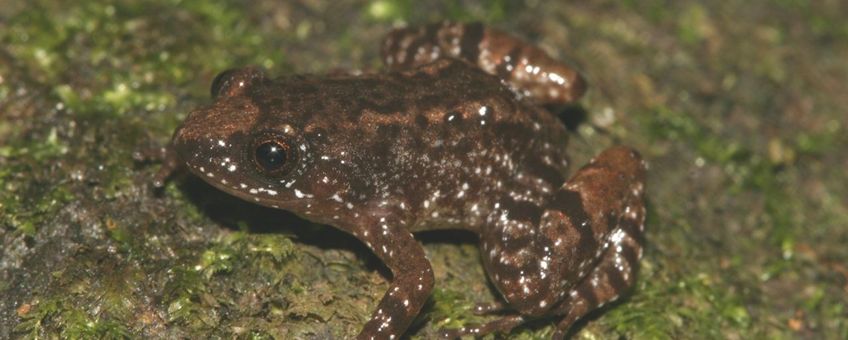
7 new frogs discovered in India, some smaller than a thumbnail
MongabayAll the newly described species belong to the genus Nyctibatrachus, commonly known as night frogs. Apart from being tiny, these frogs live a secretive life under forest leaf litter or marsh vegetation and they sound like insects, making it difficult for researchers to locate them. But these species seem to be common and abundant in the locations they were found, researchers say.
Four of these frogs are only 12 to 16 millimeters in length, making them smaller than a thumbnail. In fact, these miniature-sized amphibians are among the smallest frogs in the world, researchers report in a new study.
![Seven new species discovered from the Western Ghats. A. Radcliffe’s Night Frog (Nyctibatrachus radcliffei), B. Athirappilly Night Frog (Nyctibatrachus athirappillyensis), C. Kadalar Night Frog (Nyctibatrachus webilla), D. Sabarimala Night Frog (Nyctibatrachus sabarimalai), E. Vijayan’s Night Frog (Nyctibatrachus pulivijayani), F. Manalar Night Frog (Nyctibatrachus manalari), G. Robin Moore’s Night Frog. [(D-G. Size of the miniature species in comparison to the Indian five-rupee coin (24 mm diameter)]](http://cdn-img.newstory.nl/naturetoday/images/optimized/1abe701f-d4b2-4b12-87d8-80e41db3b742.jpg&w=770)
The world’s smallest frog is believed to be the 7.7 millimeter long Paedophryne amauensis, found in Papua New Guinea.
Finding the night frogs was not an easy task. Apart from being tiny, these frogs live a secretive life under forest leaf litter or marsh vegetation and they sound like insects, making it difficult for researchers to locate them. These frogs may have remained undiscovered for a long time, but these species seem to be common and abundant in the locations they were found, researchers say.
“The miniature species are locally abundant and fairly common but they have probably been overlooked because of their extremely small size, secretive habitats and insect-like calls,” said lead-author Sonali Garg, a PhD student at the University of Delhi.
Despite being commonly encountered, all seven species are likely to be threatened by habitat loss, researchers say. They are all known only from the single locations where they were discovered, some of which lie outside protected areas. Moreover, much of the southern Western Ghats, where the new species were discovered, is currently threatened by illegal mining, construction of hydro-power dams and large-scale infrastructure development.

Two of the frogs, Radcliffe’s night frog (Nyctibatrachus radcliffei) and the Kadalar night frog (N. webilla) for example, were found inside private or state-owned plantation areas. The Athirappilly night frog (N. athirappillyensis) was discovered near the Athirappilly waterfall in the state of Kerala, which lies inside a reserved forest that is threatened by a proposed hydroelectric project. Similarly, the Sabarimala night frog (N. sabarimalai) was found close to a popular pilgrimage center that is estimated to attract over 100 million devotees every year.
 “Over 32 percent, that is one-third of the Western Ghats frogs are already threatened with extinction. Out of the seven new species, five are facing considerable anthropogenic threats and require immediate conservation prioritization,” Prof SD Biju, who led the new study and has also formally described over 80 new species of amphibians from India, said in the statement.
“Over 32 percent, that is one-third of the Western Ghats frogs are already threatened with extinction. Out of the seven new species, five are facing considerable anthropogenic threats and require immediate conservation prioritization,” Prof SD Biju, who led the new study and has also formally described over 80 new species of amphibians from India, said in the statement.
Between 2006 and 2015, scientists described 1,581 new species of amphibians. Of these, 159 species were discovered in the Western Ghats-Sri Lanka region, making it one of the leading biodiversity hotspots for new amphibian species discoveries, researchers say.
Until now, the night frog genus Nyctibatrachus included 28 recognised species, of which more than half were described over the last five years. The discovery of the seven new species raises the number of Nyctibatrachus species to 35.
Newly discovered miniature night frogs have insect-like calls (Source: SDGM)
The results of this study are published in the scientific Open Access journal PeerJ.
Text: Shreya Dasgupta, Mongabay
Photos: David Raju (leadphoto: Nyctibatrachus anamallaiensis, one of the 28 already known species); SD Biju, University of Delhi
